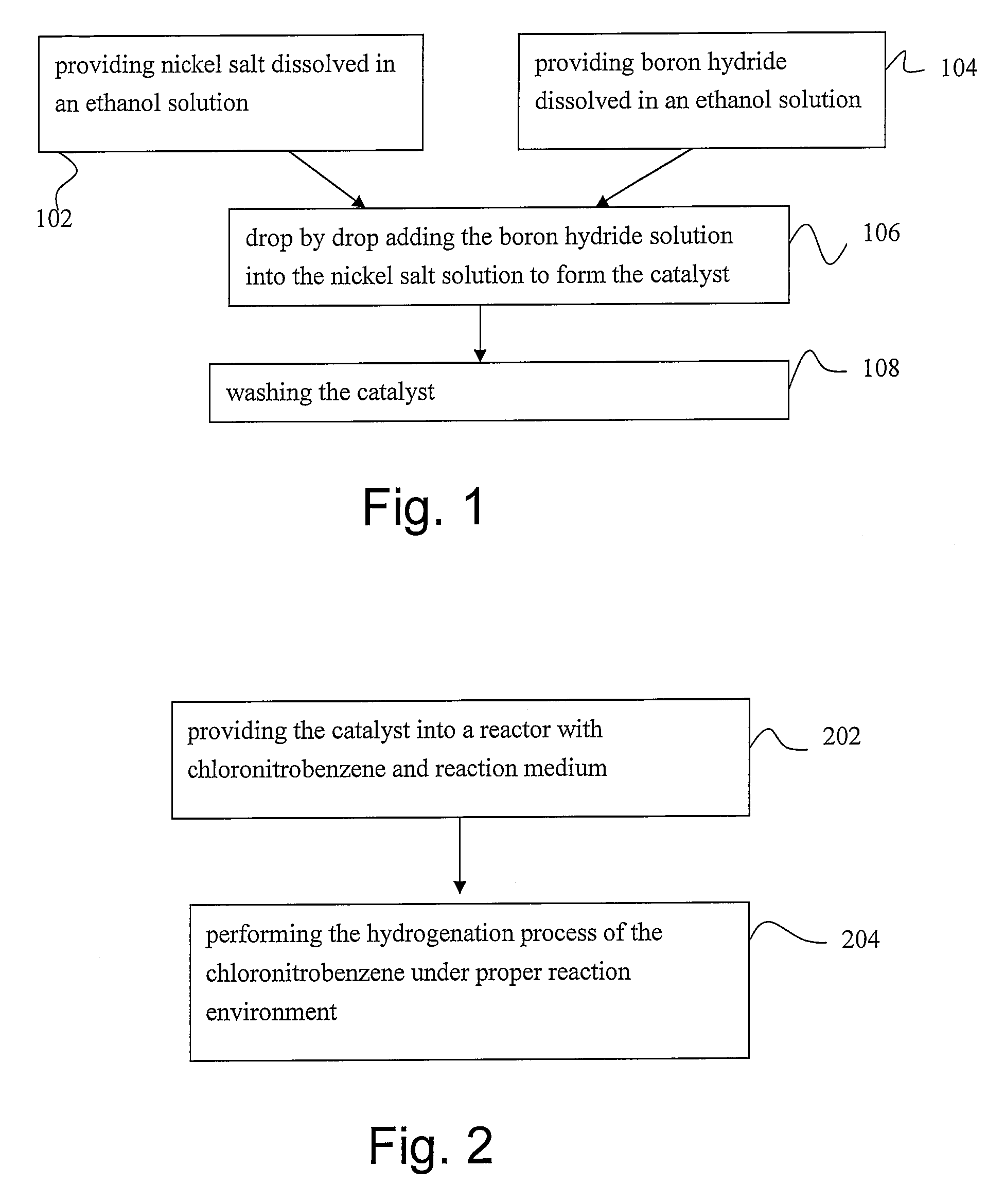Hydrogenation process of chlorinated nitrobenzene
a chlorinated nitrobenzene and chlorinated nitrobenzene technology, which is applied in the preparation of amino compounds, physical/chemical process catalysts, metal/metal-oxide/metal-hydroxide catalysts, etc., can solve the problems of high hydrogenation ability and high price of noble metals, and achieve high activity and selectivity, small diameter, and large surface area
- Summary
- Abstract
- Description
- Claims
- Application Information
AI Technical Summary
Benefits of technology
Problems solved by technology
Method used
Image
Examples
first embodiment
[0022]Nickel salt, such as nickel acetate, nickel nitrate and nickel chloride, is dissolved in a 20 ml solution composed of deionized water and ethanol to form a nickel salt solution. Notably, the nickel salt is weighted of about 0.498 g (2 mmole). Furthermore, volume ratio of the deionized water to the ethanol is 1. That is, the solution is composed of 10 ml de-ionized water and 10 ml-99.5% ethanol. Moreover, boron hydride is dissolved in a solution composed of deionized water and ethanol to form boron hydride solution. Notably, the boron hydride, such as sodium borohydride or potassium borohydride, is weighted of about 0.227 g (6 mmole). Furthermore, volume ratio of the deionized water to the ethanol is 1. That is, the solution is composed of 3 ml de-ionized water and 3 ml-99.5% ethanol. Under the zero-centigrade ice bath, the nickel salt solution is stirred with a stirring rate of about 100 rpm while the boron hydride solution is drop-by-drop added into the nickel salt solution b...
second embodiment
[0024]Nickel salt, such as nickel acetate, nickel nitrate and nickel chloride, is dissolved in a 20 ml solution composed of deionized water and ethanol to form a nickel salt solution. Notably, the nickel salt is weighted of about 0.498 g (2 mmole). Furthermore, volume ratio of the deionized water to the ethanol is 1. That is, the solution is composed of 10 ml de-ionized water and 10 ml-99.5% ethanol. Moreover, boron hydride is dissolved in a solution composed of deionized water and ethanol to form boron hydride solution. Notably, the boron hydride, such as sodium borohydride or potassium borohydride, is weighted of about 0.227 g (6 mmole). Furthermore, volume ratio of the deionized water to the ethanol is 1. That is, the solution is composed of 3 ml de-ionized water and 3 ml-99.5% ethanol. At about 20-80° C., the nickel salt solution is stirred with a stirring rate of about 500 rpm while the boron hydride solution is drop-by-drop added into the nickel salt solution by using the peri...
third embodiment
[0026]The nanosized boron-containing nickel catalyst obtained from the first embodiment is placed in a reactor, such as a slurry reactor, with chloronitrobenzene, such as ortho-chloronitrobenzene, meta-chloronitrobenzene or para-chloronitrobenzene, weighted about 2.52 g and methanol of about 80 ml. In order to expel the air in the reactor, hydrogen is pumped into the reactor for 10 min. Thereafter, the mixture of the chloronitrobenzene, methanol and the nanosized boron-containing nickel catalyst in the reactor is stirred with a low stirring rate of about 100 rpm until the reaction temperature of about 40-150 centigrade is reached simultaneously with that the pressure inside the reactor is increased to the reaction pressure of about 5-40 atm. As the reaction condition is satisfied, the stirring rate is increased to 500 rpm while the reaction time t is set to be zero (t=0) and the hydrogenation process is started. Notably, during the hydrogenation process, the hydrogen is continuously...
PUM
| Property | Measurement | Unit |
|---|---|---|
| temperature | aaaaa | aaaaa |
| pressure | aaaaa | aaaaa |
| temperature | aaaaa | aaaaa |
Abstract
Description
Claims
Application Information
 Login to View More
Login to View More - R&D
- Intellectual Property
- Life Sciences
- Materials
- Tech Scout
- Unparalleled Data Quality
- Higher Quality Content
- 60% Fewer Hallucinations
Browse by: Latest US Patents, China's latest patents, Technical Efficacy Thesaurus, Application Domain, Technology Topic, Popular Technical Reports.
© 2025 PatSnap. All rights reserved.Legal|Privacy policy|Modern Slavery Act Transparency Statement|Sitemap|About US| Contact US: help@patsnap.com

